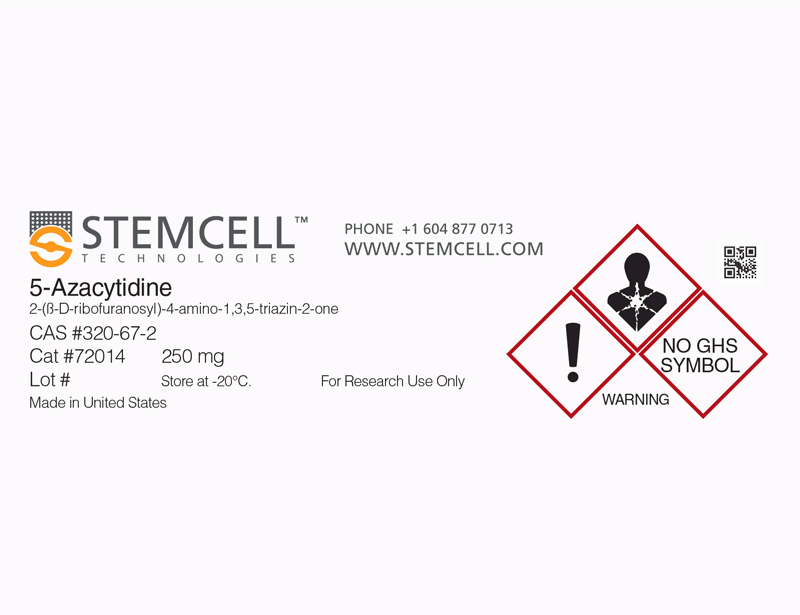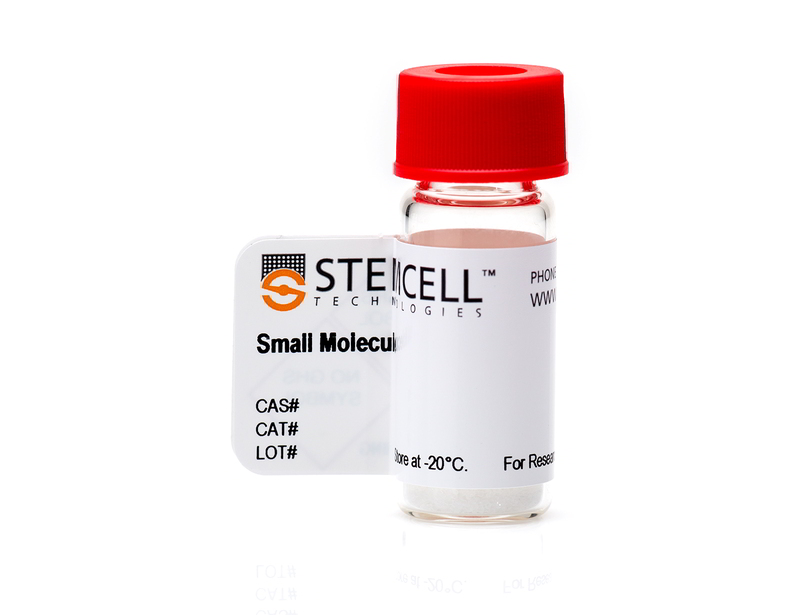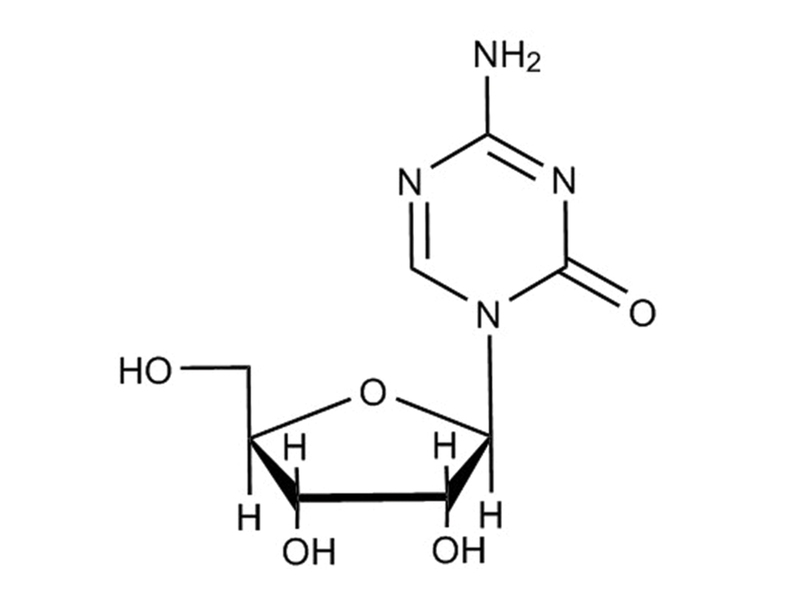5-Azacytidine
Epigenetic modifier; Inhibits DNA methyltransferase (DNMT)
概要
5-Azacytidine is an analog of the nucleoside cytidine which can be incorporated into DNA and RNA. 5-Azacytidine acts as an epigenetic modifier by incorporating into DNA where it irreversibly binds to DNA methyltransferases, thus inhibiting their activity.
REPROGRAMMING
· Increases reprogramming efficiency of mouse fibroblasts to induced pluripotent stem (iPS) cells by inducing full reprogramming of partially reprogrammed cells (Mikkelsen et al.).
· Resets epigenetic memory in mouse iPS cells, in combination with Trichostatin A (Kim et al.).
DIFFERENTIATION
· Enhances differentiation to cardiomyocytes from human embryonic stem cells (Yoon et al.).
CANCER RESEARCH
· Wide range of anti-metabolic activities when tested against cultured cancer cells and an effective chemotherapeutic agent for acute myelogenous leukemia
REPROGRAMMING
· Increases reprogramming efficiency of mouse fibroblasts to induced pluripotent stem (iPS) cells by inducing full reprogramming of partially reprogrammed cells (Mikkelsen et al.).
· Resets epigenetic memory in mouse iPS cells, in combination with Trichostatin A (Kim et al.).
DIFFERENTIATION
· Enhances differentiation to cardiomyocytes from human embryonic stem cells (Yoon et al.).
CANCER RESEARCH
· Wide range of anti-metabolic activities when tested against cultured cancer cells and an effective chemotherapeutic agent for acute myelogenous leukemia
Alternative Names
5-AzaC; Antibiotic U 18496; Ladakamycin; Mylosar; NSC 103-627; NSC 102816; U 18496; WR 183027; Zcyd
Cell Type
Cancer Cells and Cell Lines, Cardiomyocytes, PSC-Derived, Leukemia/Lymphoma Cells, Pluripotent Stem Cells
Species
Human, Mouse, Rat, Non-Human Primate, Other
Application
Differentiation, Reprogramming
Area of Interest
Cancer Research, Stem Cell Biology
CAS Number
320-67-2
Chemical Formula
C₈H₁₂N₄O₅
Molecular Weight
244.2 g/mol
Purity
≥ 95%
Pathway
Epigenetic
Target
DNMT
技术资料
| Document Type | 产品名称 | Catalog # | Lot # | 语言 |
|---|---|---|---|---|
| Product Information Sheet | 5-Azacytidine | 72012, 72014 | All | English |
| Safety Data Sheet | 5-Azacytidine | 72012, 72014 | All | English |
数据及文献
Publications (6)
Translational oncology 2014 OCT
Rewriting the epigenetic code for tumor resensitization: a review.
Abstract
Abstract
In cancer chemotherapy, one axiom, which has practically solidified into dogma, is that acquired resistance to antitumor agents or regimens, nearly inevitable in all patients with metastatic disease, remains unalterable and irreversible, rendering therapeutic rechallenge futile. However, the introduction of epigenetic therapies, including histone deacetylase inhibitors (HDACis) and DNA methyltransferase inhibitors (DNMTIs), provides oncologists, like computer programmers, with new techniques to overwrite" the modifiable software pattern of gene expression in tumors and challenge the "one and done" treatment prescription. Taking the epigenetic code-as-software analogy a step further�
Nature 2010 SEP
Epigenetic memory in induced pluripotent stem cells.
Abstract
Abstract
Somatic cell nuclear transfer and transcription-factor-based reprogramming revert adult cells to an embryonic state, and yield pluripotent stem cells that can generate all tissues. Through different mechanisms and kinetics, these two reprogramming methods reset genomic methylation, an epigenetic modification of DNA that influences gene expression, leading us to hypothesize that the resulting pluripotent stem cells might have different properties. Here we observe that low-passage induced pluripotent stem cells (iPSCs) derived by factor-based reprogramming of adult murine tissues harbour residual DNA methylation signatures characteristic of their somatic tissue of origin, which favours their differentiation along lineages related to the donor cell, while restricting alternative cell fates. Such an 'epigenetic memory' of the donor tissue could be reset by differentiation and serial reprogramming, or by treatment of iPSCs with chromatin-modifying drugs. In contrast, the differentiation and methylation of nuclear-transfer-derived pluripotent stem cells were more similar to classical embryonic stem cells than were iPSCs. Our data indicate that nuclear transfer is more effective at establishing the ground state of pluripotency than factor-based reprogramming, which can leave an epigenetic memory of the tissue of origin that may influence efforts at directed differentiation for applications in disease modelling or treatment.
Nature 2008
Dissecting direct reprogramming through integrative genomic analysis
Abstract
Abstract
Somatic cells can be reprogrammed to a pluripotent state through the ectopic expression of defined transcription factors. Understanding the mechanism and kinetics of this transformation may shed light on the nature of developmental potency and suggest strategies with improved efficiency or safety. Here we report an integrative genomic analysis of reprogramming of mouse fibroblasts and B lymphocytes. Lineage-committed cells show a complex response to the ectopic expression involving induction of genes downstream of individual reprogramming factors. Fully reprogrammed cells show gene expression and epigenetic states that are highly similar to embryonic stem cells. In contrast, stable partially reprogrammed cell lines show reactivation of a distinctive subset of stem-cell-related genes, incomplete repression of lineage-specifying transcription factors, and DNA hypermethylation at pluripotency-related loci. These observations suggest that some cells may become trapped in partially reprogrammed states owing to incomplete repression of transcription factors, and that DNA de-methylation is an inefficient step in the transition to pluripotency. We demonstrate that RNA inhibition of transcription factors can facilitate reprogramming, and that treatment with DNA methyltransferase inhibitors can improve the overall efficiency of the reprogramming process.
Differentiation; research in biological diversity 2006 APR
Enhanced differentiation of human embryonic stem cells into cardiomyocytes by combining hanging drop culture and 5-azacytidine treatment.
Abstract
Abstract
Cell replacement therapy is a promising approach for the treatment of cardiac diseases. It is, however, challenged by a limited supply of appropriate cells. Therefore, we have investigated whether functional cardiomyocytes can be efficiently generated from human embryonic stem cells (hESCs). In this study, we developed an efficient protocol for the generation of functional cardiomyocytes from hESCs by combining hanging drop culture and 5-azacytidine, a well-known demethylating agent, and then evaluated the expression of cardiac-specific markers. hESCs were cultured both in the medium without or with 0.1, 1, or 10 microM of 5-azacytidine under a hanging drop culture. The expression of several cardiac-specific markers was determined by real-time PCR, RT-PCR, immunofluorescence, and confocal microscopy. To verify the structural and functional properties of hESC-derived cardiomyocytes, we performed electron microscopy and electrophysiological recording. The efficiency of beating cell generation was significantly improved in the hanging drop culture compared with that in suspension culture. Treatment of hESCs with 0.1 microM of 5-azacytidine for 1-3 days significantly increased the number of beating cells and simultaneously enhanced the expression of cardiac-specific markers. Transmission electron microscopy and electrophysiological recording showed that hESC-derived cardiomyocytes acquired structural and functional properties of cardiomyocytes. In conclusion, these results suggest that differentiation of hESCs into cardiomyocytes can be enhanced by the combination of hanging drop culture and 5-azacytidine treatment. Also the methylation status of genes related to cardiomyocyte development may play an important role in the differentiation of hESCs into cardiomyocytes.
Cancer research 2005 JUL
Epigenetic reactivation of tumor suppressor genes by a novel small-molecule inhibitor of human DNA methyltransferases.
Abstract
Abstract
DNA methylation regulates gene expression in normal and malignant cells. The possibility to reactivate epigenetically silenced genes has generated considerable interest in the development of DNA methyltransferase inhibitors. Here, we provide a detailed characterization of RG108, a novel small molecule that effectively blocked DNA methyltransferases in vitro and did not cause covalent enzyme trapping in human cell lines. Incubation of cells with low micromolar concentrations of the compound resulted in significant demethylation of genomic DNA without any detectable toxicity. Intriguingly, RG108 caused demethylation and reactivation of tumor suppressor genes, but it did not affect the methylation of centromeric satellite sequences. These results establish RG108 as a DNA methyltransferase inhibitor with fundamentally novel characteristics that will be particularly useful for the experimental modulation of epigenetic gene regulation.
Oncogene 2002 AUG
5-Azacytidine and 5-aza-2'-deoxycytidine as inhibitors of DNA methylation: mechanistic studies and their implications for cancer therapy.
Abstract
Abstract
5-Azacytidine was first synthesized almost 40 years ago. It was demonstrated to have a wide range of anti-metabolic activities when tested against cultured cancer cells and to be an effective chemotherapeutic agent for acute myelogenous leukemia. However, because of 5-azacytidine's general toxicity, other nucleoside analogs were favored as therapeutics. The finding that 5-azacytidine was incorporated into DNA and that, when present in DNA, it inhibited DNA methylation, led to widespread use of 5-azacytidine and 5-aza-2'-deoxycytidine (Decitabine) to demonstrate the correlation between loss of methylation in specific gene regions and activation of the associated genes. There is now a revived interest in the use of Decitabine as a therapeutic agent for cancers in which epigenetic silencing of critical regulatory genes has occurred. Here, the current status of our understanding of the mechanism(s) by which 5-azacytosine residues in DNA inhibit DNA methylation is reviewed with an emphasis on the interactions of these residues with bacterial and mammalian DNA (cytosine-C5) methyltransferases. The implications of these mechanistic studies for development of less toxic inhibitors of DNA methylation are discussed.




